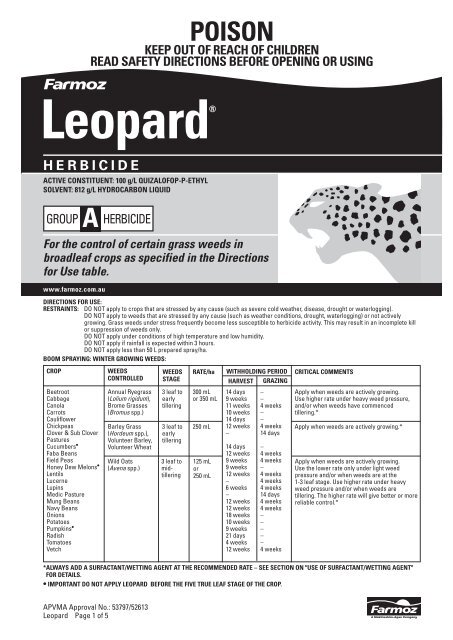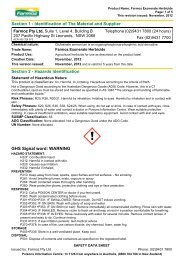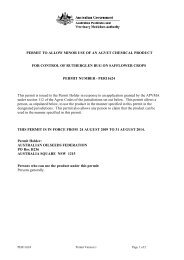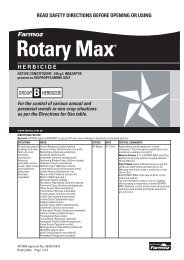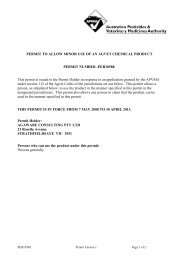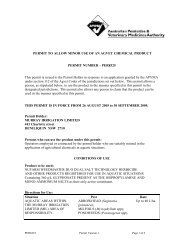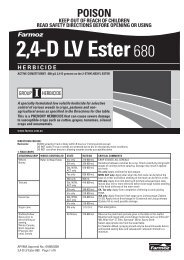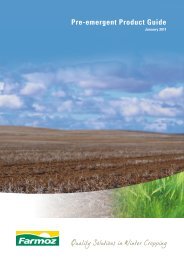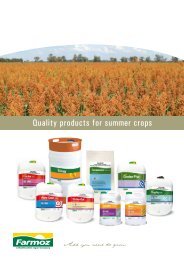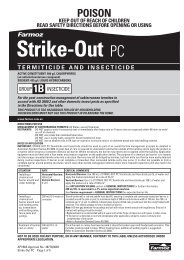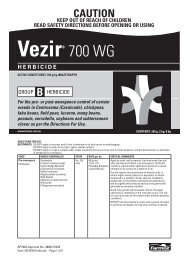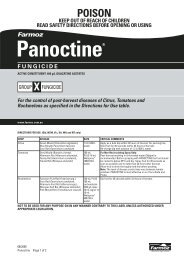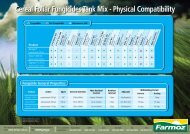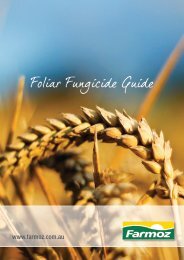Create successful ePaper yourself
Turn your PDF publications into a flip-book with our unique Google optimized e-Paper software.
For the control of certain grass weeds in<br />
broadleaf crops as specified in the Directions<br />
for Use table.<br />
www.farmoz.com.au<br />
DIRECTIONS FOR USE:<br />
RESTRAINTS: DO NOT apply to crops that are stressed by any cause (such as severe cold weather, disease, drought or waterlogging).<br />
DO NOT apply to weeds that are stressed by any cause (such as weather conditions, drought, waterlogging) or not actively<br />
growing. Grass weeds under stress frequently become less susceptible to herbicide activity. This may result in an incomplete kill<br />
or suppression of weeds only.<br />
DO NOT apply under conditions of high temperature and low humidity.<br />
DO NOT apply if rainfall is expected within 3 hours.<br />
DO NOT apply less than 50 L prepared spray/ha.<br />
BOOM SPRAYING: WINTER GROWING WEEDS:<br />
Beetroot<br />
Cabbage<br />
Canola<br />
Carrots<br />
Cauliflower<br />
Chickpeas<br />
Clover & Sub Clover<br />
Pastures<br />
Cucumbers<br />
Faba Beans<br />
Field Peas<br />
Honey Dew Melons<br />
Lentils<br />
Lucerne<br />
Lupins<br />
Medic Pasture<br />
Mung Beans<br />
Navy Beans<br />
Onions<br />
Potatoes<br />
Pumpkins<br />
Radish<br />
Tomatoes<br />
Vetch<br />
POISON<br />
KEEP OUT OF REACH OF CHILDREN<br />
READ SAFETY DIRECTIONS BEFORE OPENING OR USING<br />
Leopard®<br />
HERBICIDE<br />
ACTIVE CONSTITUENT: 100 g/L QUIZALOFOP-P-ETHYL<br />
SOLVENT: 812 g/L HYDROCARBON LIQUID<br />
GROUP A HERBICIDE<br />
CROP WEEDS<br />
CONTROLLED<br />
Annual Ryegrass<br />
(Lolium rigidum),<br />
Brome Grasses<br />
(Bromus spp.)<br />
Barley Grass<br />
(Hordeum spp.),<br />
Volunteer Barley,<br />
Volunteer Wheat<br />
Wild Oats<br />
(Avena spp.)<br />
APVMA Approval No.: 53797/52613<br />
Leopard Page 1 of 5<br />
WEEDS<br />
STAGE<br />
3 leaf to<br />
early<br />
tillering<br />
3 leaf to<br />
early<br />
tillering<br />
3 leaf to<br />
midtillering<br />
RATE/ha WITHHOLDING PERIOD<br />
HARVEST GRAZING<br />
300 mL<br />
or 350 mL<br />
14 days<br />
9 weeks<br />
11 weeks<br />
10 weeks<br />
14 days<br />
12 weeks<br />
–<br />
14 days<br />
12 weeks<br />
9 weeks<br />
9 weeks<br />
12 weeks<br />
–<br />
6 weeks<br />
–<br />
12 weeks<br />
12 weeks<br />
18 weeks<br />
10 weeks<br />
9 weeks<br />
21 days<br />
4 weeks<br />
12 weeks<br />
–<br />
–<br />
4 weeks<br />
–<br />
–<br />
4 weeks<br />
14 days<br />
–<br />
4 weeks<br />
4 weeks<br />
–<br />
4 weeks<br />
4 weeks<br />
4 weeks<br />
14 days<br />
4 weeks<br />
4 weeks<br />
–<br />
–<br />
–<br />
–<br />
–<br />
4 weeks<br />
Apply when weeds are actively growing.<br />
Use higher rate under heavy weed pressure,<br />
and/or when weeds have commenced<br />
tillering.*<br />
250 mL Apply when weeds are actively growing.*<br />
125 mL<br />
or<br />
250 mL<br />
CRITICAL COMMENTS<br />
Apply when weeds are actively growing.<br />
Use the lower rate only under light weed<br />
pressure and/or when weeds are at the<br />
1-3 leaf stage. Use higher rate under heavy<br />
weed pressure and/or when weeds are<br />
tillering. The higher rate will give better or more<br />
reliable control.*<br />
*ALWAYS ADD A SURFACTANT/WETTING AGENT AT THE RECOMMENDED RATE – SEE SECTION ON "USE OF SURFACTANT/WETTING AGENT"<br />
FOR DETAILS.<br />
IMPORTANT DO NOT APPLY LEOPARD BEFORE THE FIVE TRUE LEAF STAGE OF THE CROP.
BOOM SPRAYING: SUMMER GROWING WEEDS:<br />
CROP WEEDS<br />
CONTROLLED<br />
Beetroot<br />
Cabbage<br />
Cauliflower<br />
Carrots<br />
Cucumbers<br />
Green Beans<br />
Honey Dew Melons<br />
Lucerne<br />
Mung Beans<br />
Navy Beans<br />
Onions<br />
Peanuts<br />
Potatoes<br />
Pineapples<br />
Pumpkins<br />
Radish<br />
Soybeans<br />
Sunflower<br />
Tomatoes<br />
Leopard Page 2 of 5<br />
WEEDS RATE/ha WITHHOLDING PERIOD CRITICAL COMMENTS<br />
STAGE<br />
HARVEST GRAZING<br />
Awnless Barnyard<br />
Grass (Echinochloa<br />
colona),<br />
Barnyard Grass<br />
(Echinochloa<br />
crus-galli)<br />
3 leaf to<br />
early<br />
tillering<br />
500 mL<br />
or 750 mL<br />
14 days<br />
9 weeks<br />
14 days<br />
10 weeks<br />
14 days<br />
5 weeks<br />
–<br />
–<br />
–<br />
–<br />
–<br />
4 weeks<br />
Apply when weeds are actively growing.<br />
Use higher rate under heavy weed pressure,<br />
and/or when weeds have commenced<br />
tillering.*<br />
Couch Grass<br />
(Cynodon<br />
dactylon)<br />
2-4 leaf<br />
seedling<br />
500 mL<br />
9 weeks<br />
–<br />
12 weeks<br />
12 weeks<br />
–<br />
4 weeks<br />
4 weeks<br />
4 weeks<br />
Apply when weeds are actively growing. This rate<br />
will only control seedling Couch Grass which is<br />
less than 2 months old and established from seed.*<br />
Dinebra<br />
(Dinebra<br />
retroflexa)<br />
Crowsfoot Grass<br />
(Eleusine Indica)<br />
3 leaf to<br />
early<br />
tillering<br />
2 leaf to<br />
early<br />
tillering<br />
250 mL<br />
or 375 mL<br />
500 mL<br />
18 weeks<br />
11 weeks<br />
10 weeks<br />
7 days<br />
9 weeks<br />
21 days<br />
12 weeks<br />
–<br />
11 weeks<br />
–<br />
–<br />
–<br />
–<br />
4 weeks<br />
Apply when weeds are actively growing. Use<br />
higher rate under heavy weed pressure, and/or<br />
when weeds have commenced tillering.*<br />
Apply when weeds are actively growing.*<br />
Foxtail Millet<br />
(Setaria Italica)<br />
2 leaf to<br />
early<br />
250 mL<br />
or<br />
9 weeks<br />
4 weeks<br />
11 weeks<br />
–<br />
Apply when weeds are actively growing. Use<br />
higher rate under heavy weed pressure, and/or<br />
tillering 500 mL<br />
when weeds have commenced tillering.*<br />
Columbus Grass<br />
(Sorghum xalmum),<br />
Johnson Grass<br />
(Sorghum halepense),<br />
Liverseed Grass<br />
(Urochloa panicoides)<br />
2 leaf to<br />
3 tiller<br />
500 mL<br />
or 750 mL<br />
Rhodes Grass<br />
(Chloris gayana),<br />
Stink Grass<br />
(Eragrostis cilianensis)<br />
Queensland Blue<br />
Grass (Dichanthium<br />
sericeum)<br />
Summer Grass<br />
(Digitaria ciliaris)<br />
3 leaf to<br />
early<br />
tillering<br />
3 leaf to<br />
early<br />
tillering<br />
3 leaf to<br />
early<br />
tillering<br />
250 mL<br />
or 500 mL<br />
500 mL Apply when weeds are actively growing.*<br />
500 mL or<br />
1000 mL<br />
Apply when weeds are actively growing. Use<br />
higher rate under heavy weed pressure, and/or<br />
when weeds have commenced tillering.*<br />
*ALWAYS ADD A SURFACTANT/WETTING AGENT AT THE RECOMMENDED RATE – SEE SECTION ON "USE OF SURFACTANT/WETTING AGENT"<br />
FOR DETAILS.<br />
IMPORTANT DO NOT APPLY LEOPARD BEFORE THE FIVE TRUE LEAF STAGE OF THE CROP.
HAND GUN SPRAYING:<br />
CROP WEEDS<br />
CONTROLLED<br />
Beetroot<br />
Cabbage<br />
Cauliflower<br />
Canola<br />
Carrots<br />
Chickpeas<br />
Clover & Sub<br />
Clover Pasture<br />
Cucumbers<br />
Faba Beans<br />
Field Peas<br />
Grapes<br />
Green Beans<br />
Honey Dew Melons<br />
Lentils<br />
Lucerne<br />
Lupins<br />
Medic Pasture<br />
Mung Beans<br />
Navy Beans<br />
Non crop<br />
Onions<br />
Peanuts<br />
Pineapples<br />
Potatoes<br />
Pumpkins<br />
Radish<br />
Soybeans<br />
Sunflowers<br />
Tomatoes<br />
Vetch<br />
IMPORTANT DO NOT APPLY LEOPARD BEFORE THE FIVE TRUE LEAF STAGE OF THE CROP.<br />
NOT TO BE USED FOR ANY PURPOSE, OR IN ANY MANNER, CONTRARY TO THIS LABEL UNLESS AUTHORISED UNDER<br />
APPROPRIATE LEGISLATION.<br />
WITHHOLDING PERIODS:<br />
HARVEST:<br />
BEETROOT, CAULIFLOWER, CUCUMBERS:<br />
DO NOT HARVEST FOR 14 DAYS AFTER APPLICATION.<br />
CABBAGE, FIELD PEAS, HONEY DEW MELON, PUMPKINS, SUNFLOWERS:<br />
DO NOT HARVEST FOR 9 WEEKS AFTER APPLICATION.<br />
CARROTS, POTATOES: DO NOT HARVEST FOR 10 WEEKS AFTER APPLICATION.<br />
CHICKPEAS, FABA BEANS, LENTILS, MUNG BEANS, NAVY BEANS, SOYBEANS, VETCH:<br />
DO NOT HARVEST FOR 12 WEEKS AFTER APPLICATION.<br />
CANOLA, PEANUTS: DO NOT HARVEST FOR 11 WEEKS AFTER APPLICATION.<br />
GREEN BEANS: DO NOT HARVEST FOR 5 WEEKS AFTER APPLICATION.<br />
GRAPES: NOT REQUIRED WHEN USED AS DIRECTED.<br />
LUPINS: DO NOT HARVEST FOR 6 WEEKS AFTER APPLICATION.<br />
ONIONS: DO NOT HARVEST FOR 18 WEEKS AFTER APPLICATION.<br />
PINEAPPLES: DO NOT HARVEST FOR 7 DAYS AFTER APPLICATION.<br />
RADISH: DO NOT HARVEST FOR 21 DAYS AFTER APPLICATION.<br />
TOMATOES: DO NOT HARVEST FOR 4 WEEKS AFTER APPLICATION.<br />
GRAZING:<br />
CANOLA, CHICKPEAS, FABA BEANS, FIELD PEAS, GREEN BEANS, LENTILS, LUCERNE, LUPINS, MUNG BEANS, NAVY BEANS, SOYBEANS,<br />
VETCH: DO NOT GRAZE OR CUT FOR STOCK FEED FOR 4 WEEKS AFTER APPLICATION.<br />
CLOVER, MEDICS, PASTURES (EXCEPT LUCERNE), SUB-CLOVER:<br />
DO NOT GRAZE OR CUT FOR STOCK FEED FOR 14 DAYS AFTER APPLICATION.<br />
PEANUTS, SUNFLOWERS: DO NOT GRAZE OR CUT FOR STOCK FEED FOR 11 WEEKS AFTER APPLICATION.<br />
Leopard Page 3 of 5<br />
Awnless Barnyard<br />
Grass<br />
(Echinochloa<br />
colona),<br />
Crowsfoot Grass<br />
(Eleusine Indica)<br />
Paspalum<br />
(Paspalum<br />
dilatatum)<br />
Johnson Grass<br />
(Sorghum<br />
halepense)<br />
Kikuyu<br />
(Pennisetum<br />
clandestinum)<br />
WEEDS<br />
STAGE<br />
3 leaf to<br />
early<br />
tillering<br />
Seedling to<br />
established<br />
clumps<br />
Seedling<br />
2 leaf to<br />
early<br />
tillering<br />
Rhizome<br />
2 leaf to<br />
early<br />
tillering<br />
Seedling<br />
to<br />
established<br />
plants<br />
RATE/ha WITHHOLDING PERIOD<br />
HARVEST GRAZING<br />
125 mL 14 days<br />
9 weeks<br />
14 days<br />
11 weeks<br />
10 weeks<br />
12 weeks<br />
–<br />
125 mL<br />
125 mL<br />
250 mL<br />
250 mL<br />
14 days<br />
12 weeks<br />
9 weeks<br />
–<br />
5 weeks<br />
9 weeks<br />
12 weeks<br />
–<br />
6 weeks<br />
–<br />
12 weeks<br />
12 weeks<br />
–<br />
18 weeks<br />
11 weeks<br />
7 days<br />
10 weeks<br />
9 weeks<br />
21 days<br />
12 weeks<br />
9 weeks<br />
4 weeks<br />
12 weeks<br />
–<br />
–<br />
–<br />
4 weeks<br />
–<br />
4 weeks<br />
14 days<br />
–<br />
4 weeks<br />
4 weeks<br />
–<br />
4 weeks<br />
–<br />
4 weeks<br />
4 weeks<br />
4 weeks<br />
14 days<br />
4 weeks<br />
4 weeks<br />
–<br />
–<br />
11 weeks<br />
–<br />
–<br />
–<br />
–<br />
4 weeks<br />
11 weeks<br />
–<br />
4 weeks<br />
CRITICAL COMMENTS<br />
Apply when weeds are actively growing.<br />
Use a minimum of 800 L of prepared spray/ha.<br />
Thoroughly wet target weeds (especially well<br />
established clumps) without causing run off.<br />
Repeated sprays may be necessary for<br />
perennial grass species.<br />
Always add a surfactant/wetting agent at the<br />
recommended rate – see section on "Use of<br />
Surfactant/Wetting agent" for details.<br />
*ALWAYS ADD A SURFACTANT/WETTING AGENT AT THE RECOMMENDED RATE – SEE SECTION ON "USE OF SURFACTANT/WETTING AGENT"<br />
FOR DETAILS.
GENERAL INSTRUCTIONS<br />
LEOPARD ® is an emulsifiable concentrate herbicide used post<br />
emergence for the control of certain grass weeds in specified<br />
broadleaf crops.<br />
LEOPARD is a systemic herbicide, which is rapidly absorbed and<br />
readily translocates from the treated foliage to the root system and<br />
growing points of the plant. Applications made to grass weeds<br />
stressed due to insufficient moisture or cold temperatures may result<br />
in unsatisfactory control.<br />
RESISTANT WEEDS WARNING<br />
FARMOZ LEOPARD herbicide is a member of<br />
the Aryloxyphenoxypropionates 'Fop' group<br />
of herbicides. LEOPARD herbicide has the Inhibitors of acetyl coA<br />
carboxylase mode of action. For weed resistance management<br />
LEOPARD is a Group A Herbicide. Some naturally occurring weed<br />
biotypes resistant to LEOPARD herbicide and other Group A herbicides<br />
may exist through normal genetic variability in any weed population.<br />
The resistant individuals can eventually dominate the weed population<br />
if these herbicides are used repeatedly. These resistant weeds will not<br />
be controlled by LEOPARD herbicide or other Group A herbicides.<br />
Since the occurrence of resistant weeds is difficult to detect prior to<br />
use, FARMOZ Pty. Ltd. accepts no liability for any losses that may<br />
result from the failure of LEOPARD herbicide to control resistant<br />
weeds.<br />
Strategies to minimise the risk of herbicide resistance are available.<br />
Consult your farm chemical supplier, consultant, local Department of<br />
Agriculture or Primary Industries, or local FARMOZ Representative.<br />
TIME OF APPLICATION<br />
For maximum benefit, weeds should be sprayed when young and<br />
actively growing. Application may be made at any stage of crop<br />
growth (except to cucurbit crops), but sufficient time must be allowed<br />
for the prescribed withholding period to expire before harvest and/or<br />
grazing or cutting for stockfeed.<br />
Important: DO NOT apply LEOPARD to cucurbit crops before the five<br />
true leaf stage.<br />
SPRAY PREPARATION<br />
LEOPARD is an emulsifiable concentrate to be mixed with water and<br />
applied as a spray. Add the amount of LEOPARD directly to the spray<br />
tank and mix well.<br />
If tank mixing with Benomyl or Mancozeb, add these to the spray tank<br />
and mix thoroughly prior to adding LEOPARD.<br />
USE OF A SURFACTANT/WETTING<br />
LEOPARD may be used with either of the following adjuvant systems:<br />
1) A non-ionic surfactant (1000 g ac/L strength) at 200 mL/100 L of<br />
final spray volume (i.e. 0.2% volume/volume).<br />
2) A non-ionic surfactant (1000 g ac/L strength) at 0.1% v/v and a<br />
mineral spray oil at 1% v/v.<br />
For LEOPARD and LEOPARD tank-mixes with Sertin* 186EC, Sertin*<br />
Plus and Select* the recommended mixture is 100 mL non-ionic<br />
surfactant + 1 L DC-Trate* Spray Oil per 100 litres of final spray volume.<br />
This adjuvant system provides a more robust treatment than a<br />
surfactant only treatment and is strongly recommended.<br />
DO NOT use the surfactant + mineral oil adjuvant system on vegetable<br />
crops, use a surfactant only. DO NOT use a Spray Oil alone, a<br />
surfactant must always be added. DO NOT use spray oils of crop origin<br />
(eg Codacide oil, Synetrol oil) as spray adjuvants.<br />
COMPATIBILITIES<br />
LEOPARD is compatible with the insecticides Ballistic ® , Le Mat*,<br />
Dimethoate, endosulfan, the fungicides Benomyl and Mancozeb and<br />
the herbicides Brodal* and Victory ® when using the surfactant only<br />
adjuvant system.<br />
LEOPARD is compatible with Sertin* 186EC, Sertin* Plus and Select*<br />
when using the surfactant plus spray oil adjuvant system. When tank<br />
mixing LEOPARD and broadleaf herbicides DO NOT use a spray oil, use<br />
a surfactant only. Application of the LEOPARD tank mix may result in<br />
crop effects. The effect is temporary and usually appears as yellow or<br />
white bleaching on the leaves. New growth and subsequent yield,<br />
however, will not be affected.<br />
DO NOT add crop oil to tank mixtures of LEOPARD /Brodal. To minimise<br />
crop effects: Apply LEOPARD a minimum of 5 days prior to Brodal<br />
application or a minimum 10 days after Brodal application (14-21 days<br />
if weeds have been stressed).<br />
GROUND SPRAYING<br />
Use sprayers with flat fan or hollow cone nozzles at 210-350 kPa to<br />
give an even distribution of droplets with no less than 50% of the spray<br />
volume in the 150-300 micron range. 110° flat fan nozzles are preferred.<br />
Use between 50 and 100 litres of prepared spray/ha, the higher spray<br />
volume gives more reliable results.<br />
If weeds are large and the crop canopy is dense, increase the volume<br />
to 150 litres prepared spray/ha.<br />
Leopard Page 4 of 5<br />
GROUP A HERBICIDE<br />
For proper spray coverage adjust the boom and nozzle height<br />
according to the specifications listed by the nozzle manufacturer.<br />
Ensure the spray is evenly distributed and a double overlap spray<br />
pattern is obtained. Avoid overlapping boomspray widths and shut off<br />
spray booms while starting, turning, slowing or stopping.<br />
PROTECTION OF CROPS, NATIVE AND OTHER NON-TARGET PLANTS<br />
DO NOT apply under weather conditions or from spraying equipment,<br />
that may cause spray to drift onto nearby or susceptible plants/crops,<br />
cropping lands or pastures. DO NOT plant cereal crops into the treated<br />
area for a period of 18 weeks after application of LEOPARD.<br />
PROTECTION OF WILDLIFE, FISH, CRUSTACEANS AND<br />
ENVIRONMENT<br />
DO NOT contaminate streams, rivers or waterways with the chemical<br />
or used containers.<br />
SPRAYER CLEANUP<br />
Thoroughly clean all traces of LEOPARD from application equipment<br />
immediately after use. Flush tank, pump, hoses and boom with several<br />
changes of water after removing nozzle tips and screens (clean those<br />
parts separately). Failure to thoroughly clean the equipment may result<br />
in injury to subsequently sprayed cereal and grass crops.<br />
If spray equipment has previously been used for the application of<br />
sulfonylurea herbicides e.g. Ally*, Lynx ® WG, Harmony* M, Glean*,<br />
Tackle ® , Logran*, Lone-Star ® , Amber Post*, ensure that the<br />
recommended sprayer cleanup procedure for the product previously<br />
sprayed has been followed before using the equipment for the<br />
application of LEOPARD.<br />
STORAGE AND DISPOSAL<br />
Store in the closed, original container in a cool, well-ventilated area.<br />
DO NOT store for prolonged periods in direct sunlight. Triple rinse<br />
containers before disposal. Add rinsings to spray tank. DO NOT<br />
dispose of undiluted chemicals on site. If recycling, replace cap and<br />
return containers to recycler or designated collection point. If not<br />
recycling, break, crush or puncture and deliver empty packaging to an<br />
approved waste management facility. If an approved waste<br />
management facility is not available bury the empty packaging 500 mm<br />
below the surface in a disposal pit specifically marked and set up for<br />
this purpose clear of waterways, desirable vegetation and tree roots,<br />
in compliance with relevant Local, State or territory government<br />
regulations. DO NOT burn empty containers or product.<br />
Envirodrum Micro Matic Valve (110 L)<br />
Store the original sealed Envirodrum in a cool well-ventilated area. DO<br />
NOT store for prolonged periods in direct sunlight. DO NOT tamper<br />
with the Micro Matic valve or the security seal. DO NOT contaminate<br />
the Envirodrum with water or any foreign matter. After each use of the<br />
product, please ensure that the Micro Matic coupler delivery system<br />
and hoses are disconnected, triple rinsed with clean water and<br />
drained accordingly. When the contents of the Envirodrum have been<br />
used, please return the Envirodrum to the point of purchase. The<br />
Envirodrum remains the property of FARMOZ Pty. Ltd.<br />
1000 L<br />
Store in the closed, original container in a cool, well-ventilated area.<br />
DO NOT store for prolonged periods in direct sunlight. Storage must be<br />
secure so that contents cannot be tampered with. All locks and/or<br />
seals must be in order. If locks or seals are broken prior to initial use<br />
then the integrity of this product cannot be assured. If this occurs<br />
FARMOZ Pty. Ltd. should be advised immediately. This minibulk<br />
container is reusable and remains the property of FARMOZ Pty. Ltd. DO<br />
NOT rinse empty container. Empty contents fully into application<br />
equipment. Close all valves and return to the point of supply for refill or<br />
storage. No other liquid, solid or pesticide product should be put into it.<br />
When empty return to FARMOZ Pty. Ltd. for cleaning, relabelling and<br />
refilling.<br />
SAFETY DIRECTIONS<br />
Will irritate the eyes and skin. When preparing spray wear cotton<br />
overalls buttoned to the neck and wrist and washable hat, elbowlength<br />
PVC gloves and face shield or goggles. If product in eyes, wash<br />
out immediately with water. Wash hands after use. After each day’s<br />
use, wash gloves, face shield or goggles and contaminated clothing.<br />
FIRST AID<br />
If poisoning occurs, contact a doctor or Poisons Information Centre.<br />
Phone Australia 131126. If swallowed, DO NOT induce vomiting. Give a<br />
glass of water.<br />
MATERIAL SAFETY DATA SHEET<br />
Additional information is listed in the material safety data sheet<br />
(MSDS). A material safety data sheet for LEOPARD is available from<br />
FARMOZ on request. Call Customer Service on (02) 9431 7800.
CONDITIONS OF SALE: The use of FARMOZ LEOPARD Herbicide being beyond the<br />
control of the manufacturer, no warranty expressed or implied is given by FARMOZ<br />
Pty. Ltd., regarding its suitability, fitness or efficiency for any purpose for which it is<br />
used by the buyer, whether in accordance with the directions or not and FARMOZ Pty.<br />
Ltd. accepts no responsibility for any consequence whatsoever resulting from the use<br />
of this product.<br />
® Registered trademarks of FARMOZ Pty. Ltd.<br />
*Other Registered Trademarks<br />
PACK SIZE: 1 L, 5 L, 10 L, 20 L, 110 L, 1000 L<br />
Leopard Page 5 of 5<br />
UN No. 3082<br />
ENVIRONMENTALLY HAZARDOUS<br />
SUBSTANCE, LIQUID, N.O.S.<br />
PACKING GROUP III<br />
HAZCHEM CODE 2X<br />
MISCELLANEOUS<br />
DANGEROUS<br />
GOODS<br />
9


